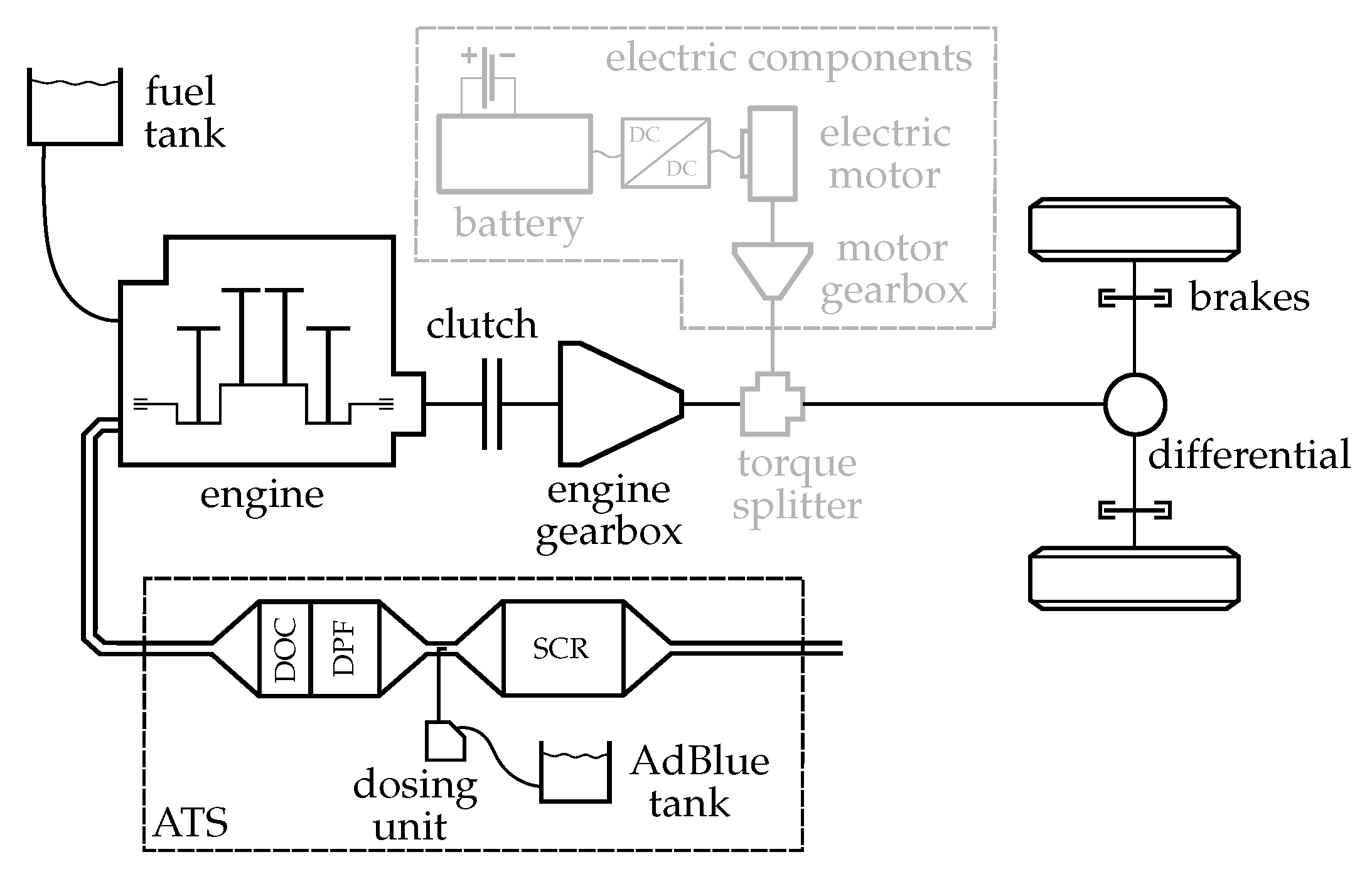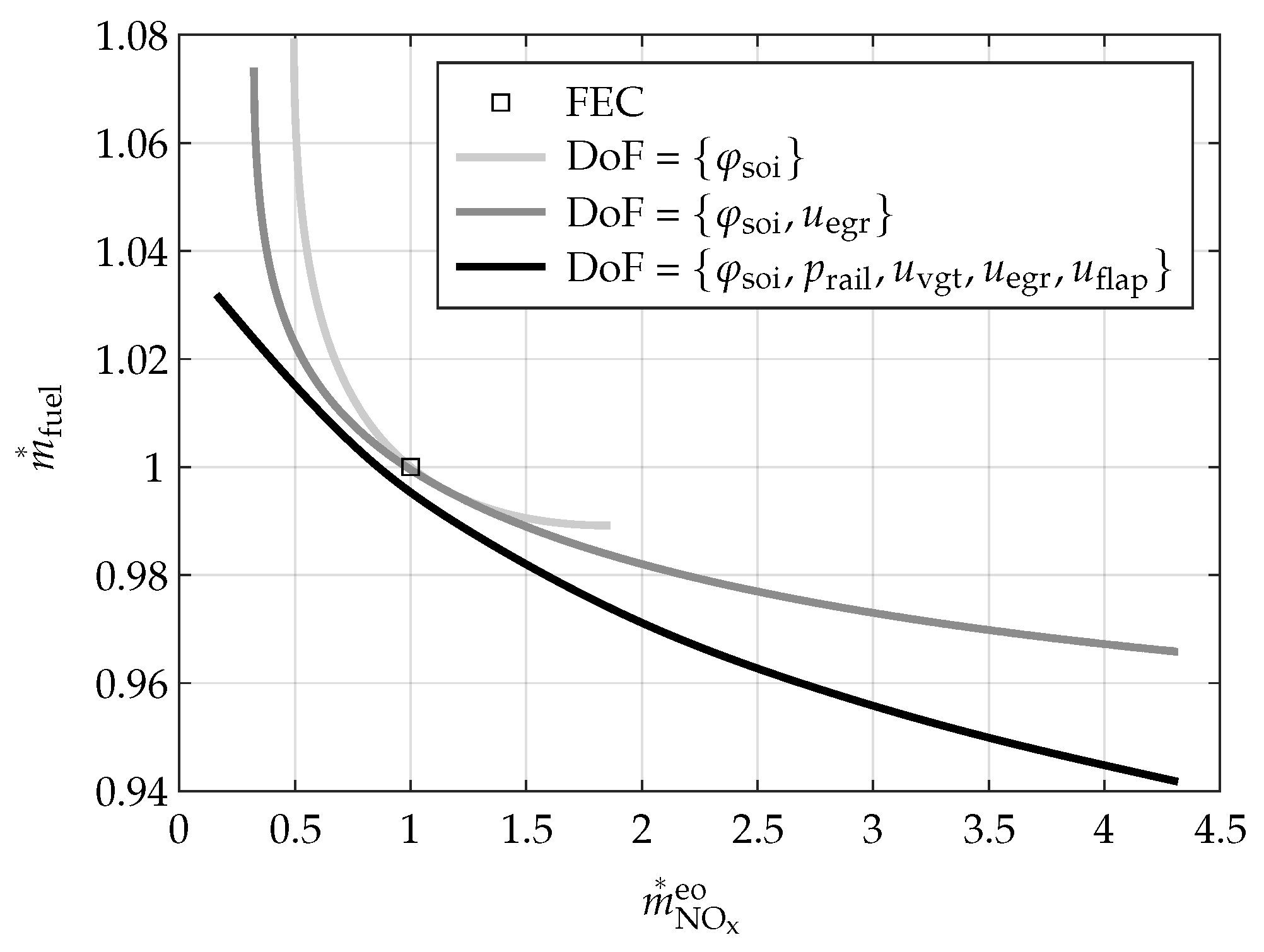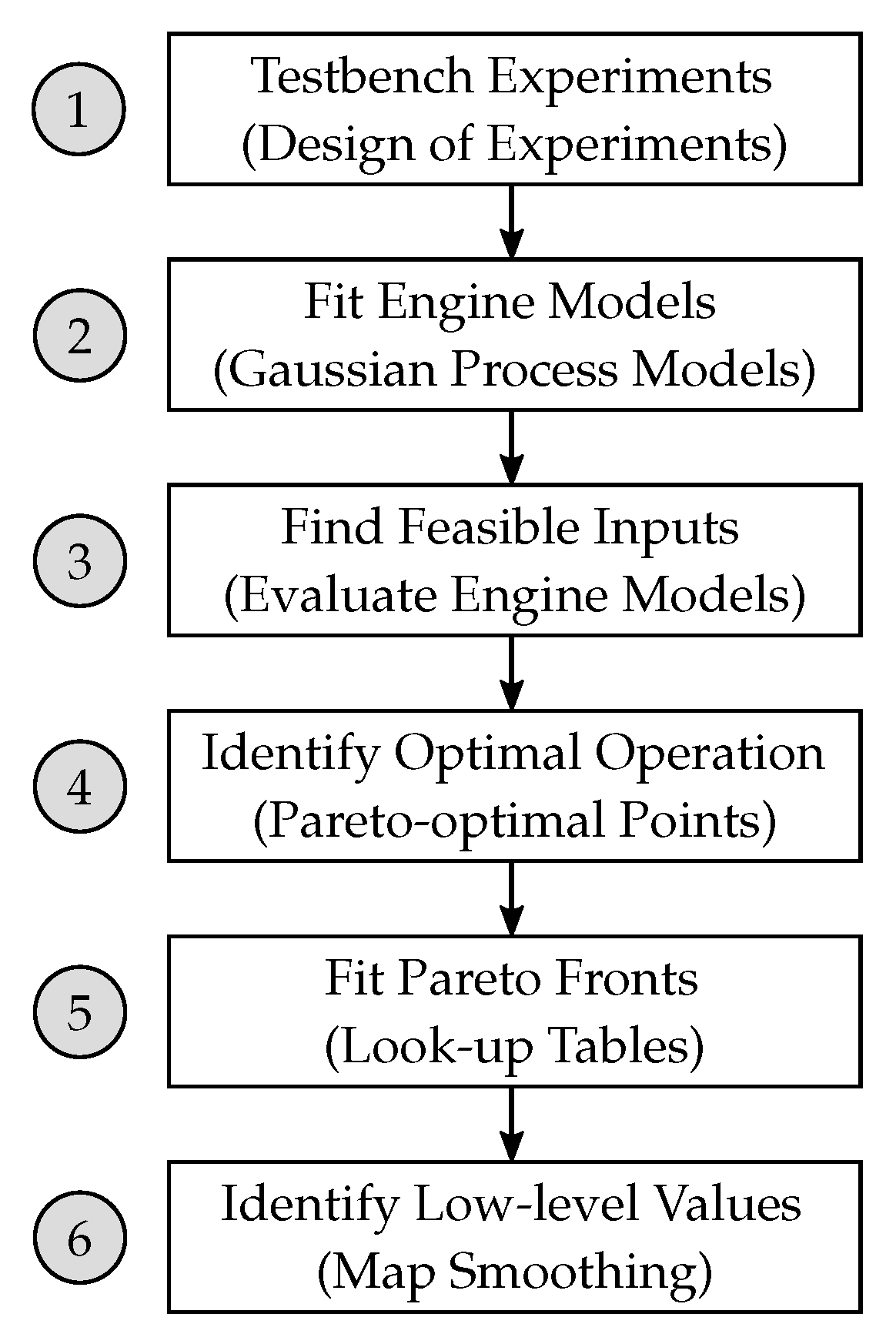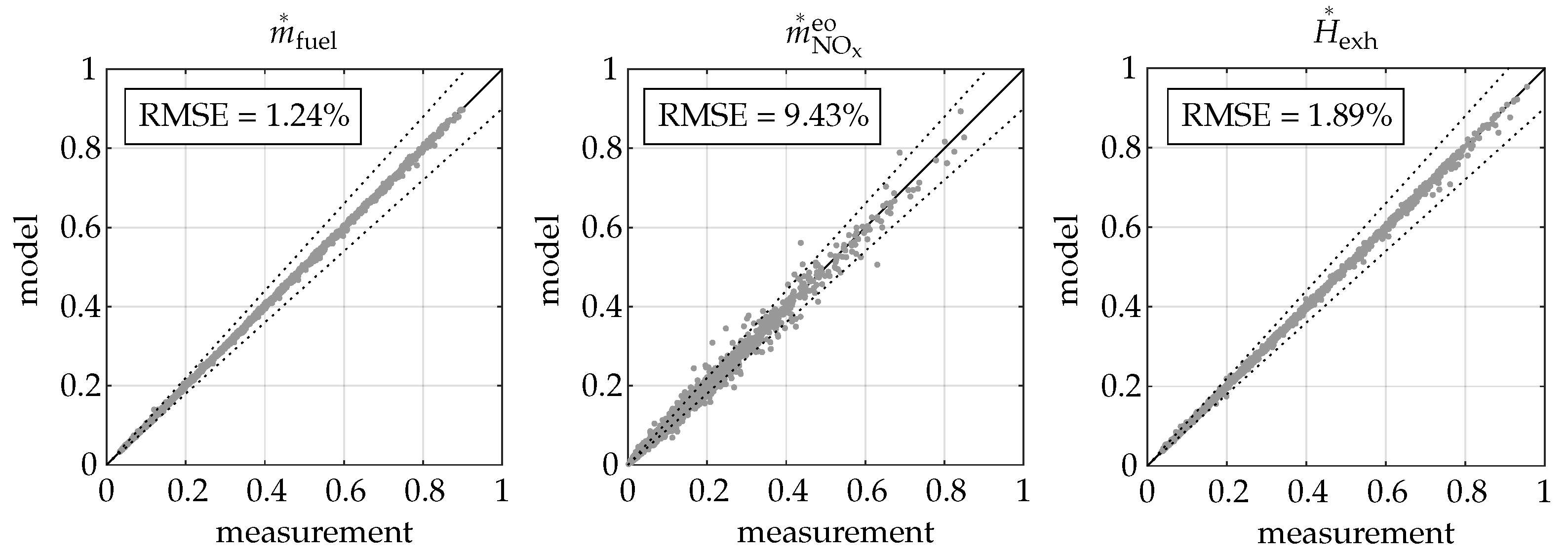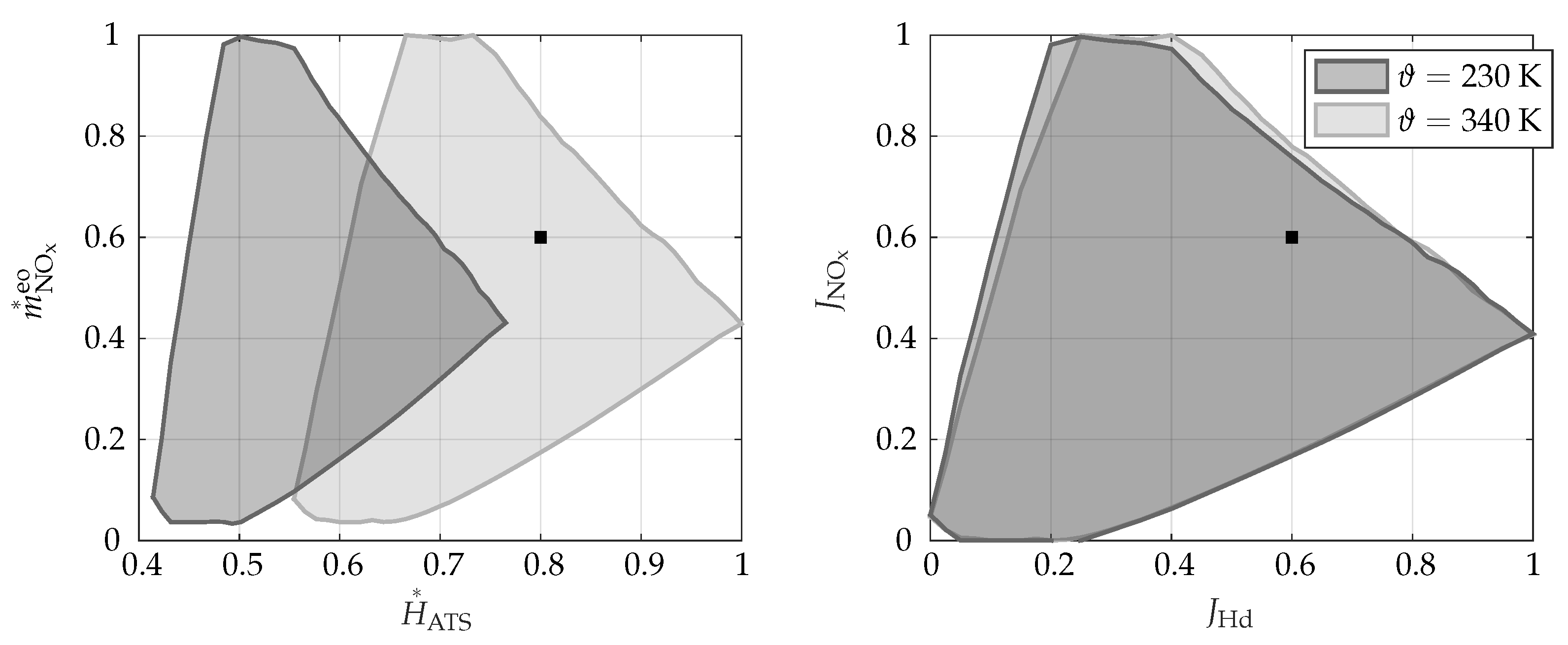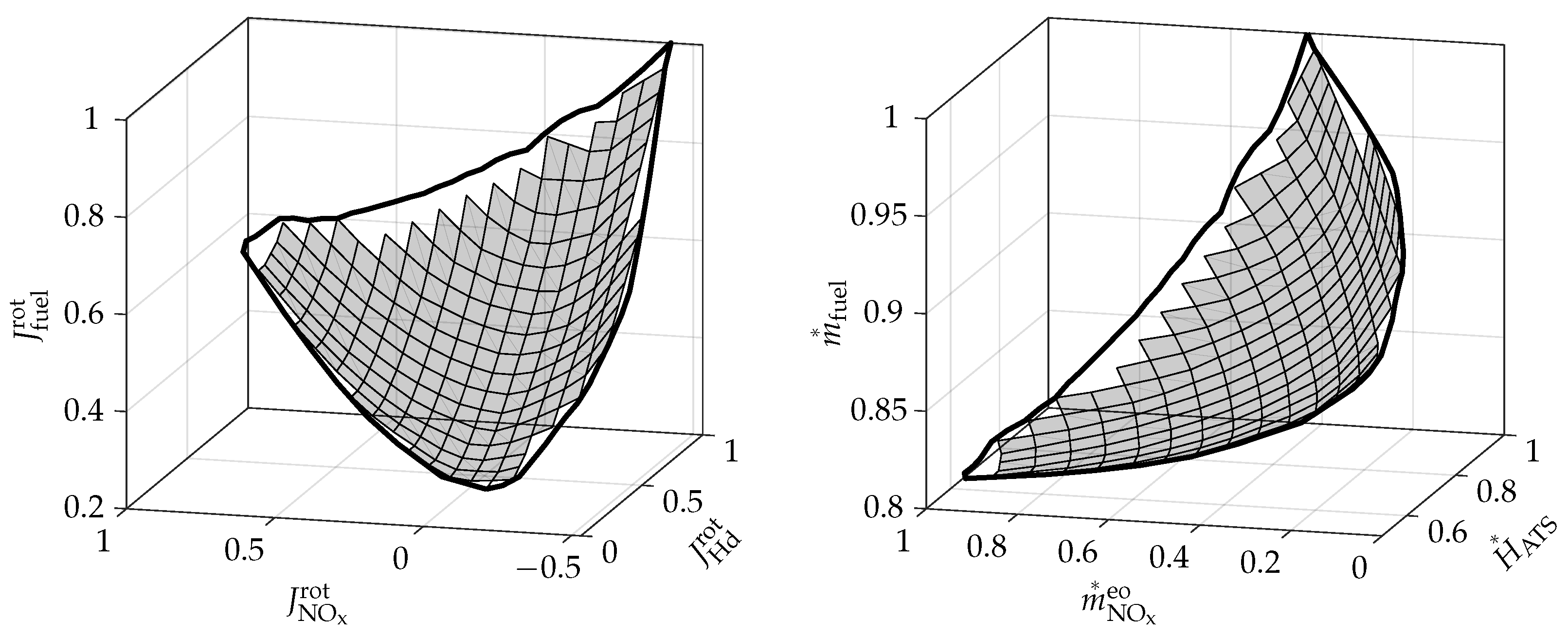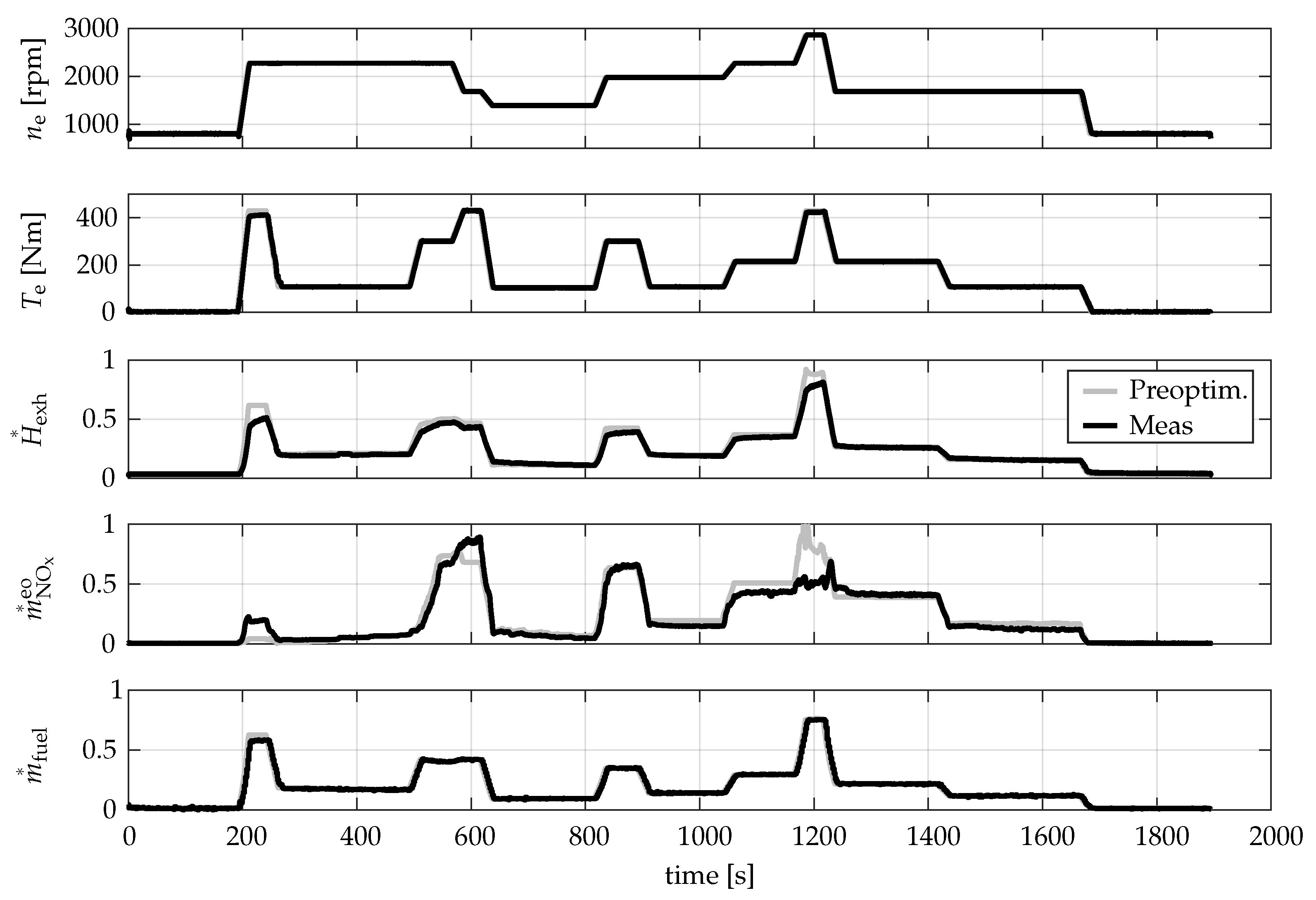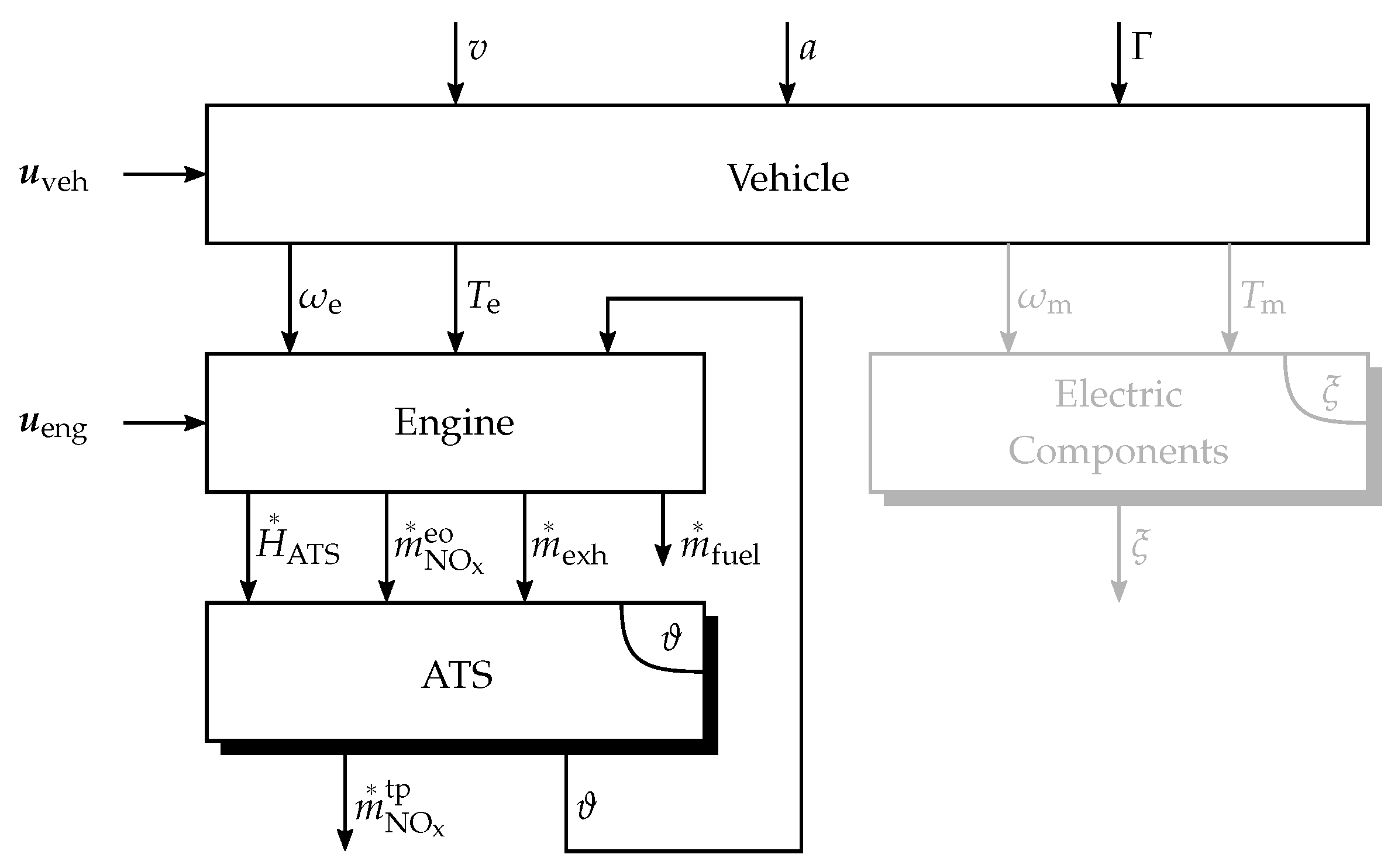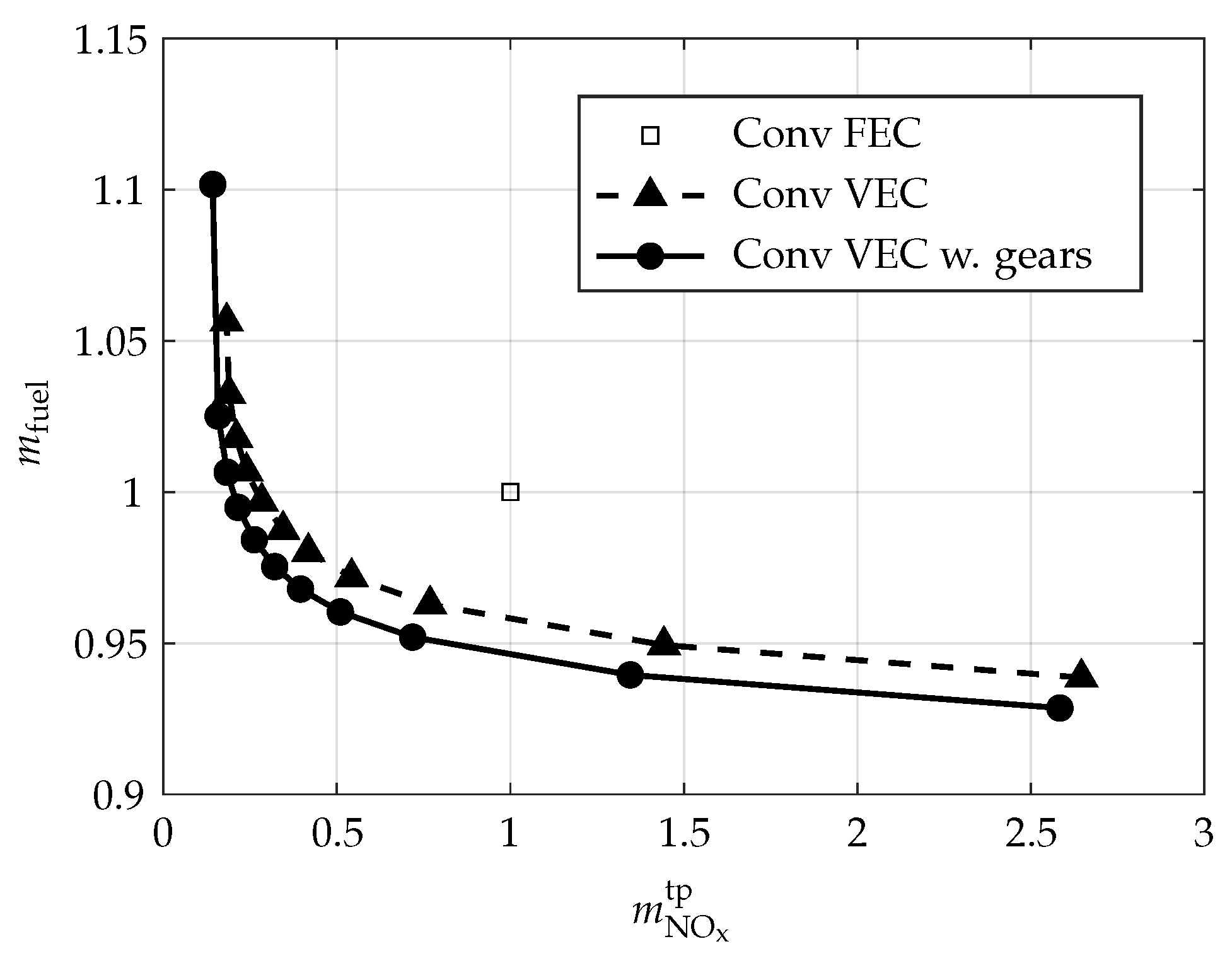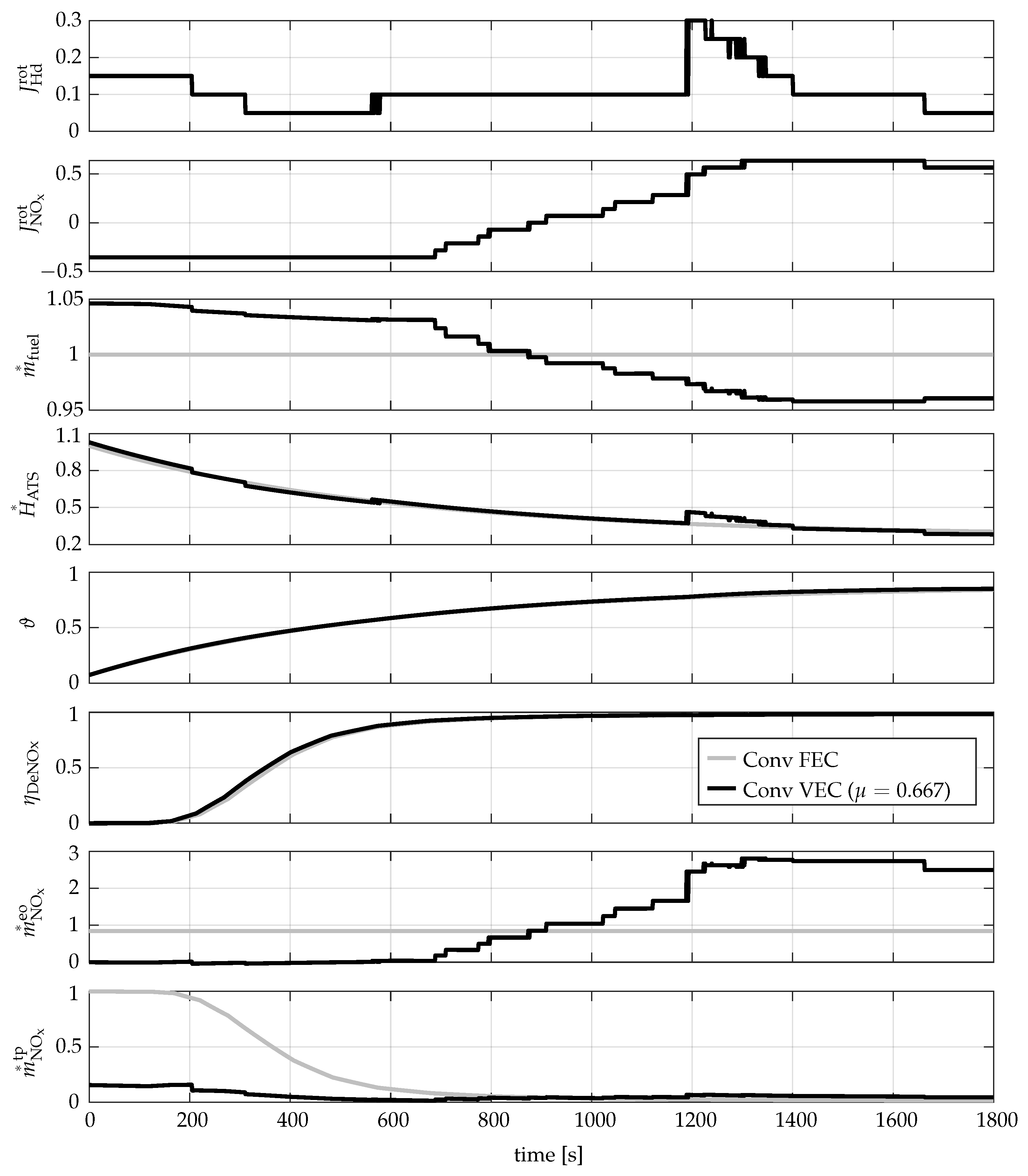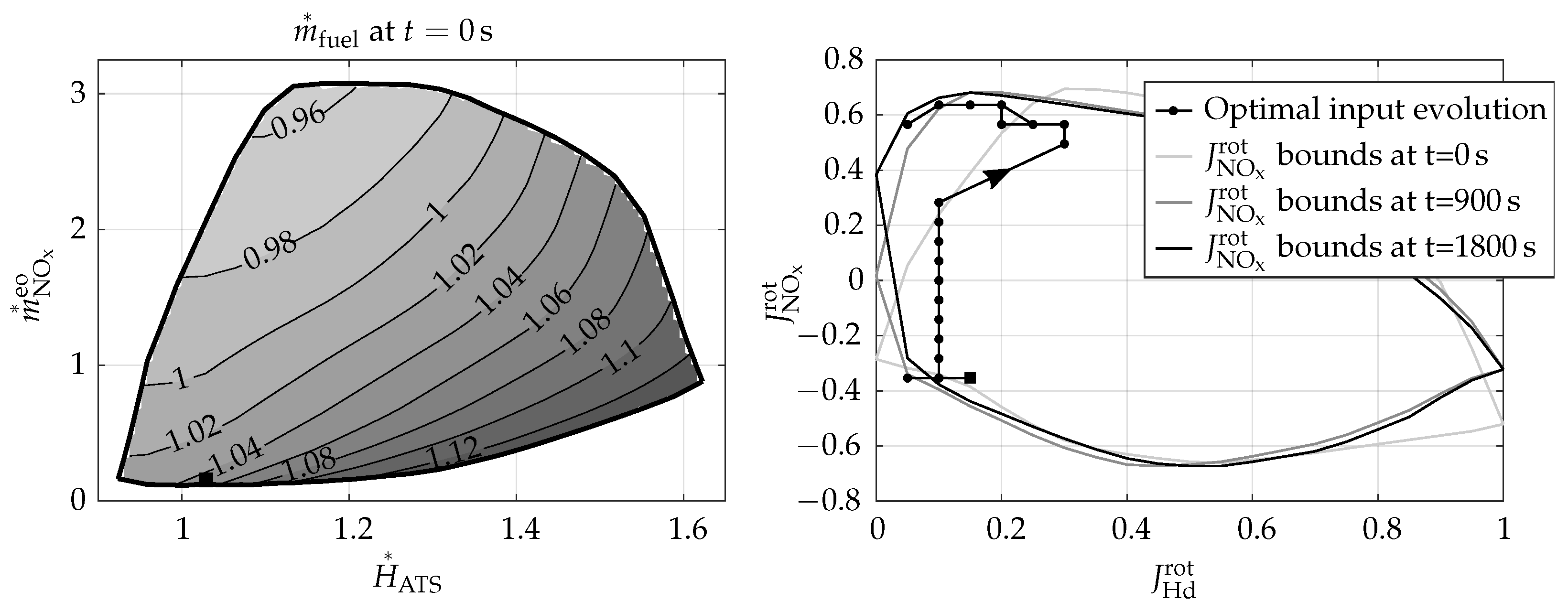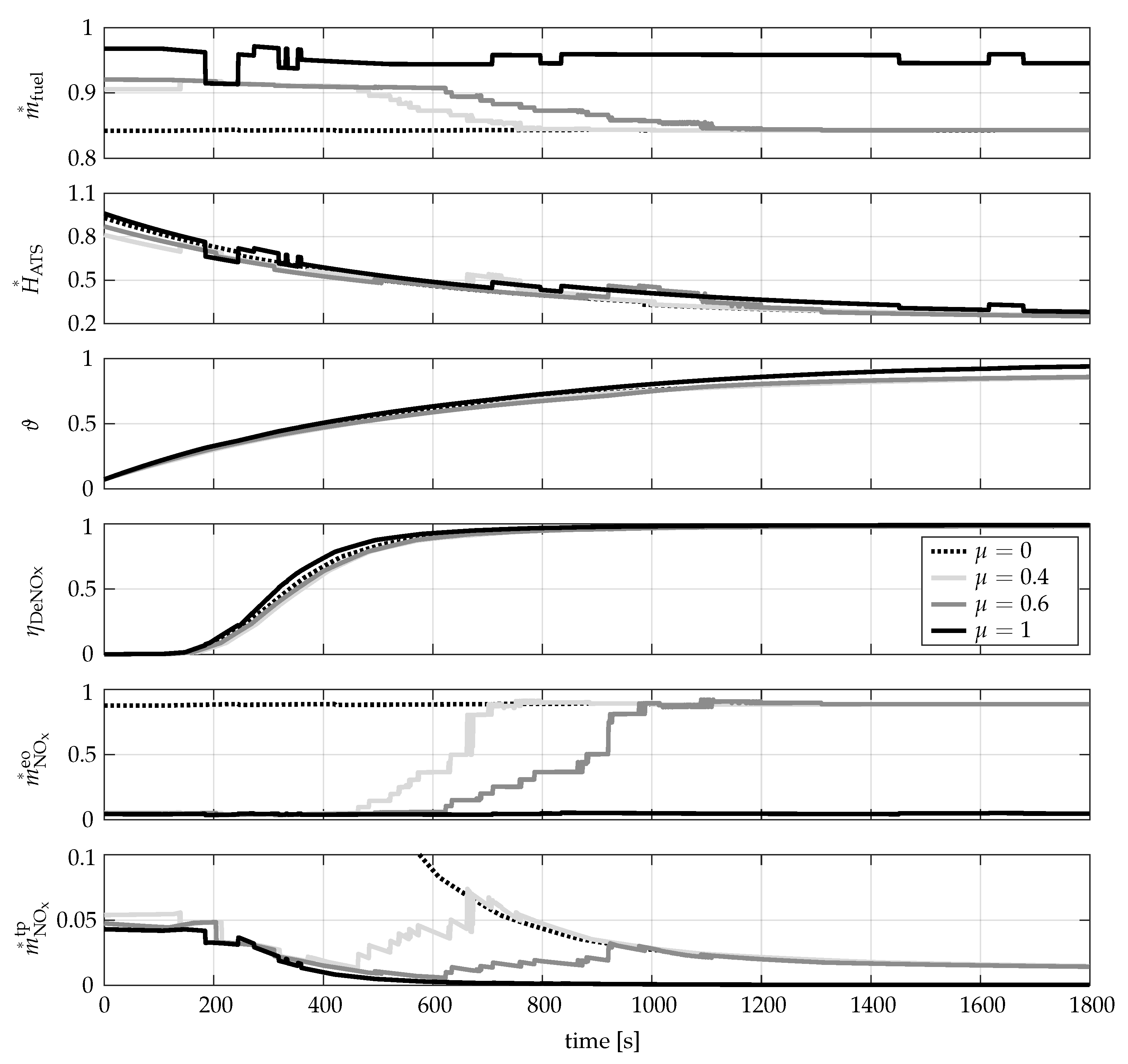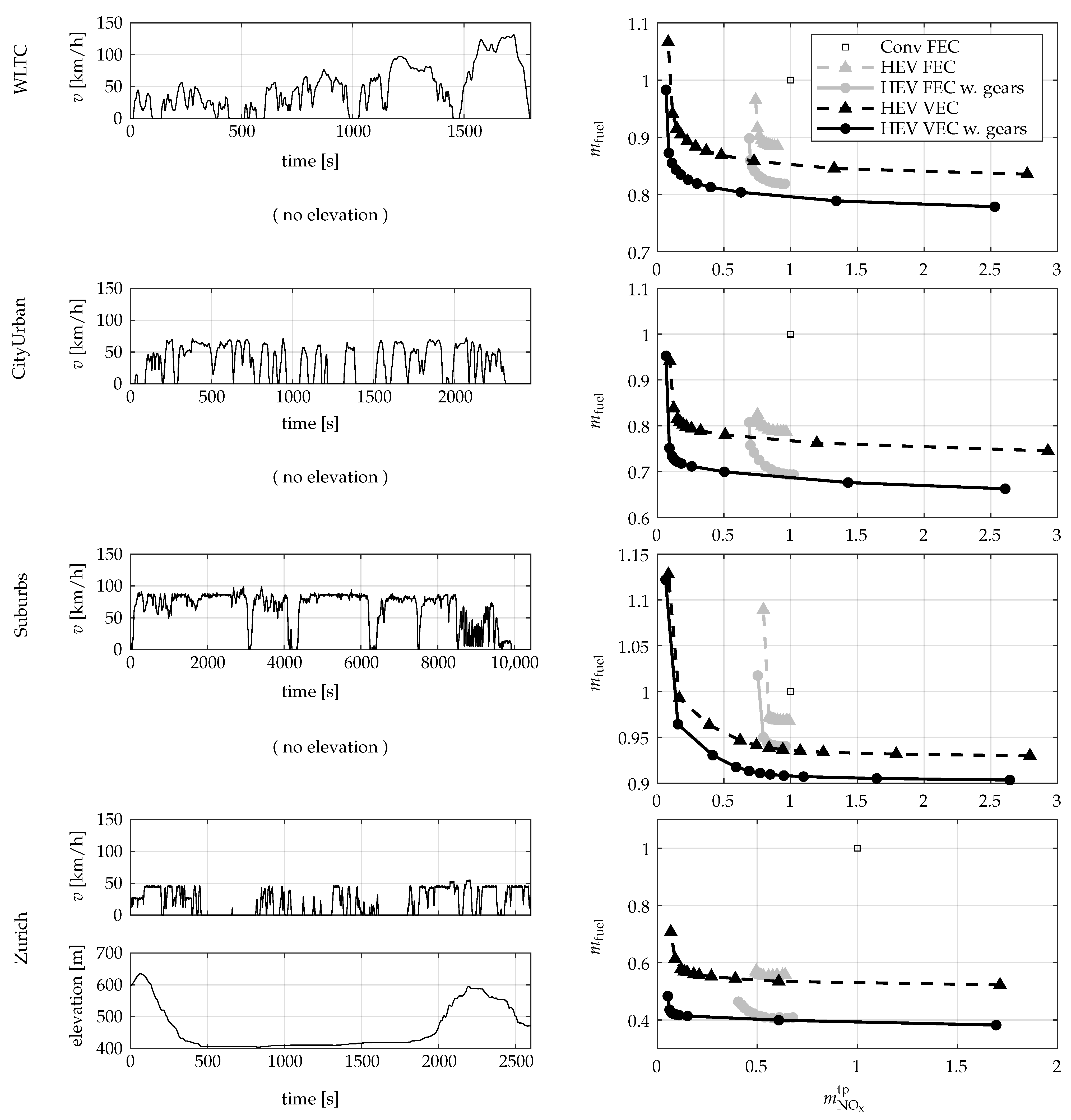3. Engine Preoptimization
Modern combustion engines have many engine control inputs that affect their operation—i.e., fuel consumption, engine-out pollutant emissions, exhaust enthalpy, etc. As they are generally over-actuated, some engine control inputs can be optimized online to adapt the engine operation for the current conditions. In the following, the engine control inputs that can be optimized during operation are referred to as degrees of freedom (DoF).
In general, the more DoF available, the better the achievable engine performance.
Figure 2 shows the achievable trade-off between fuel consumption and engine-out NO
x emissions for different sets of DoF, at fixed engine speed and torque. The operation with a fixed engine calibration (FEC), i.e., no DoF, is shown by the rectangular marker. The light gray curve shows the trade-off when the start of injection
was considered as the sole DoF. Even with a single DoF, a considerable range in engine operation becomes available. When the position of the exhaust gas recirculation (EGR) valve was included as a second DoF, the dark gray trade-off curve resulted. The Pareto-optimal region was extended significantly. When the fuel rail pressure
, the variable geometry turbine (VGT) actuator position
, and the exhaust flap position
were added to the list of DoF, the black trade-off curve resulted.
In this work, five DoF were considered, namely, the start of injection, the fuel rail pressure, the VGT actuator position, the EGR valve position, and the exhaust flap position. However, the presented preoptimization method is easily transferable to systems with different DoF.
The presented engine preoptimization method is based on the concept of Pareto-optimality for a multi-objective optimization [
27]. The goal of the preoptimization is to exclude all engine control input combinations that either result in an infeasible engine operation, i.e., where at least one engine constraint is violated, or in an engine operation that is not Pareto-optimal.
Before starting the engine preoptimization, the individual objectives of the multi-objective optimization must be defined. The control task defined in
Section 2.2 clearly states that the fuel consumption is to be minimized. Further, the engine-out NO
x mass flow is to be minimized, in order to meet the limit on the emitted tailpipe NO
x. Due to the NO
x-reduction efficiency of the ATS increasing as its temperature rises, the enthalpy provided to the ATS is to be maximized. In this work the enthalpy provided to the ATS, the engine-out NO
x mass flow, and the fuel mass flow are considered as the objectives for the engine preoptimization. The exhaust mass flow, which is required to evaluate the ATS NO
x-reduction efficiency, is considered as an output depending on the engine operation selected.
The workflow of the engine preoptimization is shown in
Figure 3. The general steps of the procedure are stated in the upper line of each block, while their specific implementation in this work is stated in parentheses underneath. The individual steps are described in the following.
3.1. Testbench Experiments
In order to characterize the engine operation, measurements were taken at a testbench. To fully characterize the engine operation in subsequent steps, it is important that, along with the speed and torque of the engine, all DoF are excited. The excitation must cover the entire range of operation—i.e., not just variations of one input at a time, but a global excitation of all possible combinations.
For this work the measurement campaign was designed using the design of experiments method. A simultaneous variation of the speed, the torque, and all DoF was carried out. Approximately 3000 steady-state measurements were required to accurately train the engine models introduced in the next step. The measurements were taken within approximately one week using an automated testing method, i.e., ORION from A&D Technology.
3.2. Fit Engine Models
Next, engine models were fitted that map the engine speed and torque and the considered engine control inputs to all output variables of interest, i.e., to all output variables relevant to the Pareto optimization, and all output variables that constitute limits to the engine operation.
In this work, Gaussian process (GP) models [
28] were trained to map the engine input variables
,
,
,
,
,
, and
to the output variables. For each output variable an individual GP model was trained. To limit the computational demand of subsequent model evaluations, sparse GP models using pseudo-inputs were trained using the method described in [
29]. The procedure to obtain the GP models was:
Figure 4 shows the model validation for the fuel mass flow, the engine-out NO
x mass flow, and the exhaust enthalpy
given as
Here, is investigated instead of , as it does not depend on the ATS temperature. The model outputs are plotted against the respective measured values. The root mean squared error (RMSE) is stated as well. The RMSE of the modeled fuel mass flow and the exhaust enthalpy is approximately 1%. As the NOx mass flow is harder to model, its RMSE amounts to approximately 10%.
3.3. Find Feasible Inputs
In the first two steps, global measurements and models were considered—i.e., the engine speed and torque were freely variable. In the following, the engine speed and torque as well as the ATS temperature were considered as fixed exogenous inputs and different combinations thereof were considered.
In this third step, the models developed previously were evaluated for all possible engine control input combinations at fixed values of engine speed and torque. The resulting engine operation was checked for feasibility by taking into account a list of operational constraints. The points deemed feasible were stored, while the points deemed infeasible were discarded.
In this work a fine grid of all possible engine control input combinations was built and used to evaluate the GP models developed in the preceding step.
The limits considered include mechanical limits, such as an upper limit on peak cylinder pressure, as well as thermal limits, such as an upper limit on the exhaust temperature, to avoid damage to the engine. Furthermore, drivability limits, such as a lower limit on the torque response, and comfort limits, such as an upper limit on engine noise, were considered to fulfill the driver expectations. Emission-related limits, such as a lower limit on the air-to-fuel ratio, were considered to guarantee a clean combustion.
As the achievable range of operation at very low loads was found to be extremely limited, a fixed operation was used for loads below 10% of the full load.
3.4. Identify Optimal Operation
In this step, the actual preoptimization was performed. Out of all the feasible engine control input combinations identified in the preceding step, the ones that are Pareto-optimal with respect to the multi-objective optimization were identified and stored, while all others were discarded.
In this work, an algorithm is used that identifies and discards dominated points, leaving only non-dominated, i.e., Pareto-optimal, points. It consists of the following three steps:
A weighted-sum minimization [
30] is performed for a grid of objective weights. In this way the points that form a convex lower envelope to the Pareto front are identified.
The feasible points are sorted. The points identified in the preceding step are placed first, followed by all other points, sorted in ascending order of .
Starting at the first point, a point is selected and compared to all other points. Thereby all points dominated by the selected point are discarded. By moving along the remaining points, selecting a point and repeating the comparison above, all dominated points are discarded.
3.5. Fit Pareto Front
In this step, the feasible and Pareto-optimal engine input combinations identified in the two preceding steps were used to parameterize a model of the Pareto front.
In this work, look-up tables were used to characterize the Pareto front. A two-dimensional look-up table was fitted to the previously identified points for each combination of fixed speed, torque, and ATS temperature. This procedure is outlined in the following and was repeated for all points on a grid of speed, torque, and ATS temperature.
To make the interpolation more robust, two transformations are applied before fitting the look-up tables. First, the physical values describing the Pareto front are scaled using their respective minimum and maximum values at the current speed, torque, and ATS temperature. The scaled variables are denoted
and are given by
The benefit of this scaling is demonstrated using the example shown in
Figure 5. According to Equation (
7) the enthalpy provided to the ATS depends on the ATS temperature. As a result, the outline of the Pareto front for a fixed engine speed and torque depends on the ATS temperature, as can be seen in the plot on the left. In this example
and
are two adjacent ATS temperature grid points and the goal is to evaluate the map at the point represented by the square marker and
. For the plot on the left, the marked point is not contained in the Pareto front for
and the interpolation fails. An ATS temperature dependent scaling results in the plot on the right and avoids this issue. A similar argument can be made for the engine speed and the engine torque.
Second, the Pareto front is rotated by 45
around the
axis. The scaled and rotated variables are denoted
and are given by
The benefit of this rotation results from the unique form of the Pareto front and the desire to use equally spaced grid points to describe the look-up tables. In the low NOx region, the fuel consumption rises steeply for a reduction in NOx emission. Hence, unless a very fine grid is used, a significant interpolation error will result in this region. This problem can be alleviated by rotating the Pareto front around the axis. The resulting Pareto front no longer has steep gradients and can be fitted using a coarser grid.
After transferring the identified Pareto-optimal points to scaled and rotated variables, a fuel-cost look-up table , as well as lower and upper bounds for , were fitted.
The resulting Pareto front is shown in
Figure 6. On the left, the Pareto front fitted to the rotated and scaled values is shown. The gray surface shows the identified Pareto front, while the solid black lines show the
bounds. On the right, the corresponding Pareto front transferred back to physically meaningful values is shown.
The final result of the preoptimization consists of the following look-up elements. Their relation to
Figure 6 is also stated.
with inputs (, , , , )—gray surface in the plot on the left
and with inputs (, , , )—solid black lines in the plot on the left
,
,
,
,
, and
with inputs (
,
,
)—required to map the plot on the left to the one on the right according to Equations (
11) to (
16)
The preoptimization presented here yields an order reduction of the online optimization performed by the supervisory controller. Instead of having to optimize the five engine control inputs (, , , , ), it is sufficient to optimize the two engine strategy inputs (, ). Further, the engine limits are fulfilled by design and do not need to be checked during online optimization.
3.6. Identify Low-Level Values
While the preoptimization developed in the preceding steps captures the Pareto-optimal engine operation, it does not return the corresponding engine control inputs, which are required to operate the engine, or the exhaust mass flow, which is required to evaluate the ATS model according to Equation (
9).
In this step, an inverse mapping is developed that returns the engine control inputs as a function of the selected Pareto-optimal operation. A similar mapping for the exhaust mass flow is obtained by evaluating the GP models at the engine control inputs obtained by the inverse mapping. Unfortunately, due to the order reduction resulting from the preoptimization, obtaining this inverse mapping is not trivial.
In this work, look-up tables mapping the Pareto-optimal operation, given by (, , , , ), to the engine control inputs , , , , and are used.
These look-up tables were obtained according to the procedure presented in [
31]. Thereby an optimization problem was solved that finds a trade-off between how close the resulting engine operation is to the Pareto front and the smoothness of the engine control input look-up tables. In [
31], a penalty on the deviation of the inputs from those on the Pareto front was used in the objective, whereas in this work the deviation of the outputs from those on the Pareto front was penalized. This has the advantage that, if the outputs are insensitive to a certain input, this input is smoothed considerably without any deterioration of the overall performance.
A look-up table for the exhaust mass flow was developed by evaluating the GP model for the exhaust mass flow at the grid points of the engine control input look-up tables. It returns for the inputs (, , , , ).
3.7. Model Validation
Figure 7 shows the engine operation obtained from the preoptimization, represented by the gray lines, compared to the operation measured at the testbench, represented by the black lines, for the world harmonized stationary cycle (WHSC).
The first plot shows the engine speed, which is controlled by the dynamometer. The second plot shows the torque delivered by the engine. At around 220 s the engine is operated at full load and the requested torque at which the preoptimization is evaluated cannot be reached at the testbench. The fuel mass flow, shown in the bottom plot, shows that insufficient fuel can be injected. This effect is also observed when the original fixed engine calibration is used. Therefore, it should not be attributed to the preoptimization. Throughout the rest of the cycle the requested torque is tracked closely, which shows that the torque response of the engine is not impaired by the preoptimization.
The bottom three plots show the outputs from the Pareto front. To exclude the effect of model mismatch in the thermal model of the ATS, is shown instead of . All three variables of interest showed reasonable performance at intermediate loads, i.e., at . The match in the fuel consumption was good even at full load, i.e., at . The match of the NOx emissions at full load is not as good. This can be attributed to a performance loss in the GP models used for the Pareto preoptimization near the bound of the considered region of operation.
Due to the thermal inertia of the exhaust, the exhaust enthalpy shows a significant dynamic behavior at load steps towards full load. The quasi-static model outputs are not reached in the short duration of the operation at full load. During prolonged full-load operation, however, the exhaust enthalpy converges to the quasi-static value. This means that, while all other dynamics are fast enough to be represented well by the quasi-static engine preoptimization, the thermal exhaust dynamic cannot be captured fully. Nevertheless, the preoptimization represents the actual system sufficiently well to be used for optimization purposes.
5. Results for a Conventional Vehicle
In this section, the DP results for the operation of a conventional vehicle are presented. Three cases with different powertrain features are considered, which are shown in
Table 3.
For cases without gear optimization, the gear resulting in the lowest fuel consumption for the vehicle with FEC was selected at each time instance. This results in the fuel-optimal operation for Conv FEC.
Figure 9 shows the trade-off between fuel consumption and emitted tailpipe NO
x for the three cases on the worldwide harmonized light vehicles test cycle (WLTC) and with an initial ATS temperature below the light-off temperature. For Conv FEC no inputs can be optimized and a fixed operation results, which is represented by the black square. When VEC is introduced, the engine operation can be optimized and the trade-off is shown by the dashed line resulted. When gear optimization is added, the operation of the vehicle can be further optimized and the trade-off shown by the solid line resulted.
Based on these trade-offs, it can be concluded that VEC opens up a considerable range in fuel consumption and tailpipe NOx emissions through online optimization of the operation to the current mission. By additionally optimizing the gear selection, the trade-off can be improved further. For a fixed NOx emission limit, compared to Conv FEC, the fuel consumption can be reduced by 4.4% using VEC alone and by 5.4% using VEC and gear optimization. If, on the other hand, the fuel consumption is fixed, the NOx emissions can be reduced by 73% using VEC alone and by 80% using VEC and gear optimization.
To investigate the origin of this improvement, a simplified driving mission was considered. A constant velocity of 80 km/h and a flat road were assumed for the duration of 1800 s. For the cases without gear optimization, a constant gear was selected throughout the mission, resulting in constant speed and torque of the engine. The initial ATS temperature was set lower than the light-off temperature.
Figure 10 shows the resulting operations for Conv FEC and Conv VEC with equal total fuel consumption (
). As the Pareto front depends on the ATS temperature, it changed throughout the cycle, even though the engine speed and torque were constant. The left plot of
Figure 11 shows the Pareto front at the initial ATS temperature. The right plot shows the evolution of the optimal engine strategy inputs and
bounds at different times along the mission.
At the start of the mission, when the ATS was cold and the NO
x-reduction efficiency was low, the engine was operated with minimal engine-out NO
x emissions and high fuel consumption. The resulting operation on the Pareto front is shown by the square in the lower left corner in the left plot of
Figure 11. At the end of the mission, the engine was operated with minimal fuel consumption and high engine-out NO
x emissions.
During the mission, the optimal engine operation was selected by carefully balancing the individual objectives of the Pareto front. From the start of the mission to 700 s, the engine-out NOx emissions were kept to a minimum. The operation was shifted towards the bottom left corner of the Pareto front, which resulted in a gradual decrease in the fuel consumption. From 700 to 1200 s, the engine-out NOx emissions were increased and the fuel consumption was decreased. The operation was shifted upwards along the left-hand boundary of the Pareto front. As the NOx-reduction efficiency of the ATS rose, the tailpipe NOx emissions remained low. At 1200 s, the operation jumped to a higher engine-out NOx mass flow and a higher enthalpy provided to the ATS at equal fuel consumption. On the Pareto front, this corresponds to a jump along an iso-fuel line. From 1200 to 1400 s, Conv VEC increased the enthalpy provided to the ATS—i.e., active ATS heating occurred. At the end of this active heating phase, the ATS temperature was around 6 C higher than for Conv FEC. During this active heating phase, the operation was gradually moved to the left of the Pareto front towards the fuel-optimal operation. From 1400 s to the end of the cycle, the engine was operated near the fuel-optimal operation. As the ATS was then fully operational, the engine-out NOx emissions were successfully reduced, and the tailpipe NOx emissions remained low.
It is worth pointing out that the active ATS heating phase occurred when the NOx-reduction efficiency was already high, i.e., above 90%. Actively heating the ATS at very low ATS temperatures does not result in a direct advantage, as the increase in the current NOx-reduction efficiency is negligible, but it leads to higher heat losses throughout the mission. When the ATS is not operational, instead of actively heating the ATS, the engine-out NOx emissions should be minimized. Only once the NOx-reduction efficiency reaches a certain level, is it beneficial to increase the enthalpy provided to the ATS at the cost of an increased fuel consumption and/or engine-out NOx emissions.
To investigate the differences in operation for different NO
x optimization weights, the optimal solutions for four values of
are shown in
Figure 12. The dotted line represents the fuel-optimal operation, i.e.,
. The three solid lines show the operation for increasing
.
For the fuel-optimal operation was selected throughout the cycle. In the plot of the Pareto front, this corresponds to the top left corner. The resulting constant engine operation led to very high tailpipe NOx emissions at the beginning of the cycle.
For
, i.e., NO
x-minimal operation, the engine operation was consistently selected in the region with minimal engine-out NO
x emisions, i.e., near the square marker shown in the left plot of
Figure 11. Within this region, the operation was chosen as far to the right as possible, without entering the region where increasing the enthalpy provided to the ATS results in an increase in engine-out NO
x emissions. This means that even if the fuel consumption is of no interest, it is not worth increasing the ATS temperature, if this results in an increase of the engine-out NO
x emissions. This is equivalent to stating that the current cost corresponding to an increase in tailpipe NO
x emissions will outweigh any future advantage that can be achieved by actively heating the ATS.
The optimal solutions for and underwent the same phases as the solution for , which was analyzed above. However, the duration and the timing of the individual phases differed among the solutions. For each of the phases—low NOx, gradual shift to higher NOx, and active ATS heating—was shorter than its counterpart for . The fuel-optimal operation was reached sooner, resulting in lower overall fuel consumption with higher tailpipe NOx emissions.
The unsmooth input trajectories observed in the DP optimization results were attributed to the linear interpolation used to evaluate the look-up tables. To achieve smoother input trajectories, a continuously differentiable model of the Pareto front should be developed and used instead of the look-up tables. Only then will a finer discretization of the states and inputs in the DP optimization be advantageous. In this work, the focus was on investigating the potential of vehicles with different powertrain features. As a result, many DP optimizations for different powertrain features and driving missions must carried out, and it is more important to limit the computational demand of these optimizations than to achieve smooth input trajectories.
6. Results for an HEV
In this section, the DP results for the operation of an HEV are presented. In the following, the five cases shown in
Table 4 are considered.
For the HEV cases without gear optimization, it was assumed that the clutch was engaged whenever the vehicle was moving. This means that while purely electric driving was possible, the engine needed to be motored and added a significant drag. When gear optimization was introduced, it was assumed that the clutch was disengaged during fuel cut-off phases. As a result, the engine could be decoupled rather than motored during purely electric driving.
During the investigation, the four driving missions shown in
Figure 13 were considered. The plots on the left show the vehicle velocity, and where applicable, the elevation profile for each driving mission. The plots on the right show, the corresponding trade-offs between the fuel consumption and the emitted tailpipe NO
x. First, the WLTC is considered. The second driving mission, denoted CityUrban, was an urban mission obtained with a vehicle comparable to the one considered in this work. The third driving mission, denoted Suburbs, was obtained in the same way, but featured higher velocities and was much longer. The first three driving missions were assumed to feature a flat road. The fourth driving mission, denoted Zurich, was obtained using the method presented in [
34] and included a pronounced elevation profile from which the road gradient was calculated.
The potential for fuel consumption reduction through hybridization is strongly dependent on the vehicle mission. Missions with frequent braking phases or pronounced elevation profiles offer ample opportunity for recuperation. As a result, through hybridization alone, the fuel consumption on the WLTC, the CityUrban driving mission, and the Zurich driving mission, could be reduced by roughly 12%, 21%, and 45%, respectively, when the NOx emission limit was set to that of Conv FEC. For the Suburbs driving mission, which featured prolonged operation at higher velocity and did not offer any significant recuperation phases, the achievable reduction in the fuel consumption was only 3%.
For a constant requested power, the fuel consumption increases with a rising engine speed, while the engine-out NOx emissions remain approximately constant. As a result, the effect of the gear selection on the fuel consumption was more pronounced than its effect on the NOx emissions. The achievable advantage through gear optimizing was larger for missions with low and/or frequently changing vehicle velocities. The fuel consumption was also lower, as the gear optimization allowed the engine drag losses to be avoided during fuel cut-off phases by decoupling the engine from the drivetrain.
While optimizing the vehicle inputs enabled a trade-off between fuel consumption and NOx emission, this region was drastically extended for all missions considered if VEC was enabled. Most notably, the region with very low NOx emissions could only be reached if the engine operation could also be optimized by the supervisory controller.
In summary, the results show that while hybridization on its own offers the possibility to significantly reduce the fuel consumption, the potential to reduce the vehicle’s tailpipe NOx emissions is limited. When additionally VEC is enabled, a further, but limited reduction in the fuel consumption is possible, while the tailpipe NOx emissions can be reduced drastically.
7. Conclusions
In this work, the potential for improving the trade-off between fuel consumption and tailpipe NOx emissions through variable engine calibration (VEC) was investigated for both conventional and hybrid electric vehicles (HEV). First, a preoptimization procedure was presented that simplifies the powertrain optimization without any loss of performance. Next, dynamic programming (DP) was used to find the optimal fuel versus tailpipe NOx trade-off curves for different vehicle configurations and driving missions.
The presented engine preoptimization results in an order reduction in the optimal control problem that must be solved by the supervisory controller and guarantees a feasible engine operation. As a result, the powertrain optimization becomes much less computationally demanding.
Simulation results showed that, for a conventional vehicle and the worldwide harmonized light vehicles test cycle (WLTC), the fuel consumption can be reduced by 4.4% at equivalent NOx emissions when VEC is introduced. If, additionally, the gears are optimized, the fuel consumption can be reduced by a further 1%. At equivalent fuel consumption, the tailpipe NOx emissions can be reduced by 73% when VEC is introduced, and by a further 7% when the gears are also optimized.
For an HEV without gear optimization and all cycles considered, the achievable trade-off in fuel consumption and tailpipe NOx emissions was increased considerably through the introduction of VEC in simulation. A similar improvement was obtained for an HEV with gear optimization.
Pollutant emission limits of future emissions legislation are expected to be lowered drastically [
35]. As a result, there is a strong need for technological advances that can reduce pollutant emissions, ideally without further increasing powertrain complexity. In this work, it was shown that VEC can be considered a key enabler for meeting strict pollutant legislation, as the powertrain operation can be adapted to the respective driving mission. Thereby the performance of a given powertrain is maximized solely through software.
The proposed engine preoptimization method can easily be applied to a multitude of different engine configurations, as the engine model used by the supervisory controller, i.e., the Pareto front, no longer depends on the specific engine configuration but only on the objectives for which the Pareto front is formed. This simplifies the transferability of the method, as the optimal control problem (OCP) that must be solved is independent of the specific engine configuration. Furthermore, the order reduction of the OCP results in a faster optimization and forms the first step towards online optimization.
Based on the work presented in this publication, there are two avenues for future research. First, the presented method can be used to investigate the potential of powertrain layouts and can help identify an optimal powertrain configuration and component sizing.
Second, the presented methodology can be used as the basis for the development of an online optimal controller. A promising approach is to implement a model predictive control algorithm that optimizes the operation of the powertrain for a predicted driving mission online. By reoptimizing the vehicle operation periodically, the algorithm can account for mispredictions of the driving mission and model mismatches.
